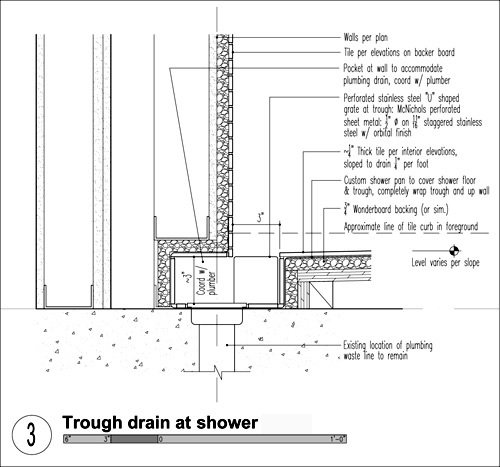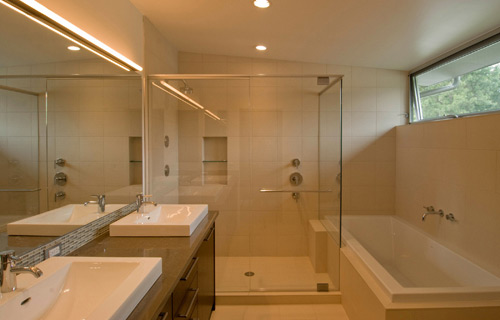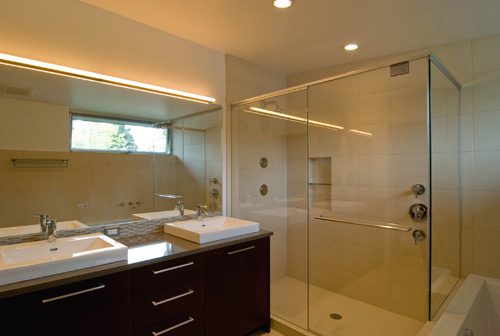
[Photo by BUILD LLC]
With any new home or remodel, the bathroom is a space of much design scrutiny. From the tile selection to whether or not the shower-head can remember your desired water temperature, everything about a bathroom is personal and intimate. Bathrooms may very well be the most personalized area of a home and we’re noticing a promising design development; that homeowners are more apt to make design decisions about how they actually live rather than design based on what a typical bathroom is supposed to look like. This is leading to some bold moves –most notably is that we’re designing and building dedicated showers either in addition to a separate bathtub or to replace the bathtub entirely. It makes sense to us, I mean who’s taking all these baths?
With the shower becoming a little room unto itself there’s a lot of customization that can occur. Today’s post covers 5 important details for shower design in the modern home.

[Photo by BUILD LLC]
![]() Shadow Box By using the depth of the framed wall, most shower enclosures are capable of including a recessed pocket to hold shampoo, soap, your rubber ducky, etc. We like the detail because it’s clean, modern and lends well to the philosophy that everything should have a place to be put away. There’s typically about 14” of clear space between the vertical wall studs –which is enough space to sneak one of these in without changing the framing around. By the time the wall assembly is in place you’ve got about 12” of width. Because there are fewer limits to the height of the recessed box, we tend to maximize the vertical opening and install a glass shelf. Most important to the aesthetics of the box is that the opening align with the grout pattern. It’s essential for the carpenter and the tile-setter to coordinate on this.
Shadow Box By using the depth of the framed wall, most shower enclosures are capable of including a recessed pocket to hold shampoo, soap, your rubber ducky, etc. We like the detail because it’s clean, modern and lends well to the philosophy that everything should have a place to be put away. There’s typically about 14” of clear space between the vertical wall studs –which is enough space to sneak one of these in without changing the framing around. By the time the wall assembly is in place you’ve got about 12” of width. Because there are fewer limits to the height of the recessed box, we tend to maximize the vertical opening and install a glass shelf. Most important to the aesthetics of the box is that the opening align with the grout pattern. It’s essential for the carpenter and the tile-setter to coordinate on this.

[Photos by BUILD LLC]
![]() Drain Trough It always bugs us to see a shower floor where all the tiles are cut up into odd little angles and slopes to allow the water to drain correctly. We designed up a drain “trough” which allows the shower floor to sheet drain in one direction only. This keeps the shower tiles to full squares –no funny angles. The trough is then capped with a piece of bent, perforated sheet steel. The final composition is clean and modern.
Drain Trough It always bugs us to see a shower floor where all the tiles are cut up into odd little angles and slopes to allow the water to drain correctly. We designed up a drain “trough” which allows the shower floor to sheet drain in one direction only. This keeps the shower tiles to full squares –no funny angles. The trough is then capped with a piece of bent, perforated sheet steel. The final composition is clean and modern.


[Photos and details by BUILD LLC]
This detail can get a little trickier in condominiums where a fixed shower drain-line may not necessarily align with where you want to locate the trough. In the application below, the shower drain line was located in concrete and we used a buck-out inside the wall to connect the trough to the fixed drain location.

[Detail by BUILD LLC]
![]() Modern Curb The threshold between the bathroom floor and the shower floor is important both functionally and visually. Functionally it keeps the water in the shower area. Visually it provides an appropriate place to change tile geometry, tile pattern or just change to a different tile entirely. The shift from horizontal floor to vertical curb makes the change deliberate. Because the scale of the bathroom is very different from the scale of the shower, we’ll often use the same floor tile at both but change to a smaller tile geometry at the shower. This keeps an appropriate scale at the smaller space. It also makes more grout lines which gives the shower floor more grip. The curb also establishes a good place to line up the glass enclosure.
Modern Curb The threshold between the bathroom floor and the shower floor is important both functionally and visually. Functionally it keeps the water in the shower area. Visually it provides an appropriate place to change tile geometry, tile pattern or just change to a different tile entirely. The shift from horizontal floor to vertical curb makes the change deliberate. Because the scale of the bathroom is very different from the scale of the shower, we’ll often use the same floor tile at both but change to a smaller tile geometry at the shower. This keeps an appropriate scale at the smaller space. It also makes more grout lines which gives the shower floor more grip. The curb also establishes a good place to line up the glass enclosure.

[Detail by BUILD LLC]
![]() Beauty Step Lately we’ve been adding in a small tile step to the shower composition. It helps women (and perhaps world class swimmers or Tour de France cyclists…) shave their legs without having to be contortionists. The step looks best when its geometry conforms to the tile pattern.
Beauty Step Lately we’ve been adding in a small tile step to the shower composition. It helps women (and perhaps world class swimmers or Tour de France cyclists…) shave their legs without having to be contortionists. The step looks best when its geometry conforms to the tile pattern.

[Photo by BUILD LLC]
![]() Shower Light It’s an easy little detail that makes a tremendous difference. We like to use the 5” Juno IC series recessed can light above the shower with a white vapor proof trim.
Shower Light It’s an easy little detail that makes a tremendous difference. We like to use the 5” Juno IC series recessed can light above the shower with a white vapor proof trim.

[Photo by BUILD LLC]
For more of the technical scoop behind our projects follow us on Twitter.





